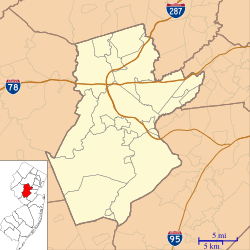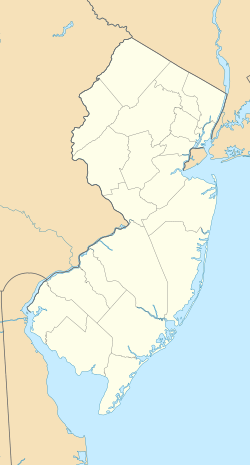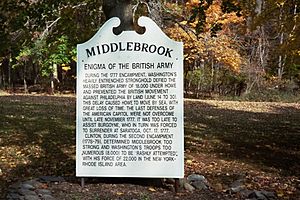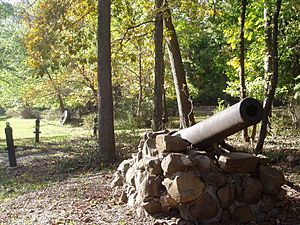Middlebrook encampment facts for kids
The Middlebrook encampment refers to two times when the Continental Army, led by General George Washington, stayed in central New Jersey. These camps were near a stream called the Middle Brook in Bridgewater Township, New Jersey. People usually tell them apart by when they happened: the First Encampment in 1777 and the Second Encampment (also called a cantonment) in 1778–1779.
|
Middlebrook Encampment Site
|
|
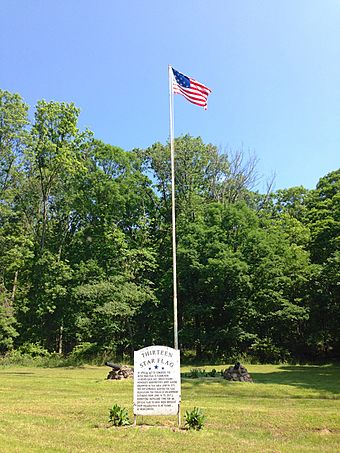
A Thirteen Star Flag at the Middlebrook encampment is displayed continuously.
|
|
| Location | Middlebrook Road, Bridgewater Township, New Jersey |
|---|---|
| NRHP reference No. | 75001160 |
Quick facts for kids Significant dates |
|
| Added to NRHP | July 3, 1975 |
The First Middlebrook encampment happened in the spring of 1777. General Washington's army stayed there during the American Revolutionary War. The second, longer stay was a winter cantonment from December 1778 to June 1779. A cantonment means an army stays in one place for a long time, usually through the winter.
Part of the first camp site is now called the Washington Camp Ground. It was added to the National Register of Historic Places in 1975. This area is in Martinsville, a part of Bridgewater Township. The Middlebrook Encampment site is on the First Watchung Mountain.
This mountain position was like a natural fort. It protected the Continental Army. It also gave them a view of the plains toward New Brunswick. British forces were stationed there in 1777. The army's strong position on the Watchung Mountain helped them win the war. It made the war last longer and tired out the British.
Contents
First Middlebrook: The Spring Encampment (1777)
In the winter of 1776–1777, Washington's army was camped in Morristown, New Jersey. After a small battle in Bound Brook in April 1777, Washington moved his army closer. They set up the Middlebrook encampment on May 28, 1777. They stayed there until July 2.
There were 8,298 soldiers in the camp. But 2,660 of them were sick or hurt and could not fight. The British army had about 17,000 soldiers near New Brunswick. From the high Watchung Mountains, Washington could watch the British. He could also plan how to stop their moves.
When British General Howe wanted to attack Philadelphia, he was worried about Washington's army. So, he chose to go by sea instead of by land. This made the British plans much slower. It also stopped them from sending help to General Burgoyne in New York. On June 30, Howe moved his troops to Staten Island. Two days later, Washington left Middlebrook. He moved his army to Pompton Plains, New York.
First Flag: June 1777
Many people believe the first official flag of the United States was shown here. This happened at the Middlebrook encampment. Congress had passed a law to adopt a national flag on June 14, 1777.
This important event is celebrated every year on July 4. People change the flag, read the Declaration of Independence, and give a speech. This happens at the Washington Camp Ground. Also, a special Thirteen Star Flag flies 24 hours a day at the Washington Camp Ground. This is by order of the Congress.
Second Middlebrook: The Cantonment (1778–1779)
Washington used the area around Middlebrook for a winter camp. This was called the Middlebrook Cantonment. It was during the winter of 1778–1779. He brought about 8,000 to 10,000 troops to the area. They arrived between November 1778 and January 1779. Washington himself arrived in early December.
The main camp spread across a large part of Somerset County. This included areas like South Bound Brook, Finderne, Somerville, and Raritan. It also included Pluckemin to the north.
Soldiers built cabins from logs covered with clay. They made them better than the huts from the previous winter at Valley Forge. Washington rented the Wallace House in Somerville. He used it as his headquarters for six months. General von Steuben lived at the Staats House. General Henry Knox lived at the Jacobus Vanderveer House near Pluckemin. Nathanael Greene lived at the Van Veghten House. General William Alexander, Lord Stirling, lived at the Philip Van Horne House.
The main British army was in New York that winter. Washington again used the safe Watchung heights. From there, he watched British troop movements. He also kept a strong defensive position. The camp ended on June 3, 1779. Washington led his army north to Highlands, New York.
Today
The Washington Camp Ground is on Middlebrook Road in Bridgewater Township. Local people made it a historic site in 1889. It was added to the National Register of Historic Places in 1975. The Camp Ground Association owns and protects the site. They also organize the annual July 4 program there. This program includes reading the complete Declaration of Independence. This has been read there every July 4 for over 100 years.
Other places related to the Middlebrook encampment are open to the public. These include Washington Rock State Park. This is a viewing spot on top of the Watchung mountain ridge. Washington Valley Park in Bridgewater is also nearby. A sign about the encampment stands at Chimney Rock and Gilbride Roads in Bridgewater.
All five colonial homes that were used as headquarters by the generals are preserved. They are now National Register Sites and are open to the public. You can find more information on their websites. The Heritage Trail Association offers a driving tour of the Middlebrook Cantonment area. They also organize a "Five Generals Tour" with the sites.


